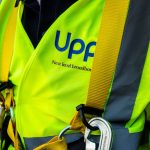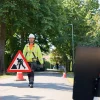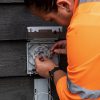Car Crash Knocks Out Openreach Broadband and Pole in Dorset UK Town UPDATE2

Hundreds of people in the Dorset town of Beaminster have reportedly been left without working broadband and digital phone connectivity for several days after a car crashed into one of Openreach’s telecoms (telegraph) poles in the area and promptly burst into flames. Police are currently still trying to locate the driver, which could suggest a criminal aspect.
The event itself, which happened near the A356 in Beaminster, occurred on Sunday (12th October 2025) night and a crew from the Beaminster Fire Station (credits for the picture), using one breathing apparatus and two hosereel jets, were finally able to extinguish the fire by 10:49pm. Unfortunately, the pole must have been carrying one of Openreach’s primary fibre cables, as it was initially reported to have disrupted connectivity for 1,000 customers in the area.
In an urban area it might only take a few hours to resolve a downed pole, or a few short days, but the situation becomes more complex once there’s something like a fire and car crash involved. In this case, the mitigating circumstances will have involved the need to make the site safe for engineers to work (e.g. the car was finally removed on Tuesday) and to allow time for the police to conduct their investigation first. Not to mention that the operator may have had to seek prior permission for traffic management measures etc.
Advertisement
An Openreach spokesperson said (BBC News):
“We’re fully assessing the impact and how much damage has been caused. Then we hope to have a clearer indication of exactly how long it will take before services are restored.
Installing a new pole and rebuilding the damaged fibre network is a complex task, but we understand how disruptive it is for local residents to be without broadband.
Our engineers are working as quickly and safely as possible to restore services and get things back to normal.”
At present it’s not known precisely when Openreach will be able to complete replacement of the pole and its cables. The operator has previously informed ISPreview that it can take an average of around 20 days to fix damaged poles, such as after a major storm. But over the years we’ve seen examples where, in rare cases of extreme damage, some smaller remote rural areas have been left to wait for several months before repairs (here, here and here).
UPDATE 9:49am
We’ve got an updated statement from Openreach.
A spokesperson for Openreach said:
“Our engineers are installing a new pole this morning (Thursday) to replace the one destroyed in Sunday’s incident, which involved a car fire.
The damage is extensive, making this a complex repair, but our highly skilled teams are working swiftly and safely to restore service.
Once the new pole is in place, crews are ready to immediately begin installing overhead cables and reconnecting customers to the network.
We’re aiming to have service restored by the end of Friday, provided there are no unexpected complications.”
UPDATE 17th Oct 2025 @ 11:28am
Advertisement
We’ve had another update from Openreach.
An Openreach spokesperson said:
“Following the car fire on Sunday night, a replacement pole was installed yesterday (Thursday), and our engineers worked through the night to reconnect the damaged cables and restore service.
The repair was complex, but it’s exactly the kind of challenge our teams are trained for – they worked quickly and safely to get the job done. Customers affected by this week’s disruption should now be reconnected to the network and back in service. We’re grateful for everyone’s patience and understanding.
If anyone is still experiencing issues, please contact your service provider as soon as possible – our engineers remain in the area and are ready to help.”
Mark is a professional technology writer, IT consultant and computer engineer from Dorset (England), he also founded ISPreview in 1999 and enjoys analysing the latest telecoms and broadband developments. Find me on X (Twitter), Mastodon, Facebook, BlueSky, Threads.net and Linkedin.
« Virgin Media O2 UK Trial mmW 5G Band for Broadband Speeds of 4Gbps UPDATE
Advertisement
Leave a Reply Cancel reply
Privacy Notice: Please note that news comments are anonymous, which means that we do NOT require you to enter any real personal details to post a message and display names can be almost anything you like (provided they do not contain offensive language or impersonate a real person�s legal name). By clicking to submit a post you agree to storing your entries for comment content, display name, IP and email in our database, for as long as the post remains live.
Only the submitted name and comment will be displayed in public, while the rest will be kept private (we will never share this outside of ISPreview, regardless of whether the data is real or fake). This comment system uses submitted IP, email and website address data to spot abuse and spammers. All data is transferred via an encrypted (https secure) session.






















































That’s why important infrastructure shouldn’t be hung along poles.
Yes in an ideal world, but unfortunately it has to be balanced with the not-too-trivial matter of being able to find a few million sympathetic customers and end users happy to pay significant more on their bills to fund all network infrastructure being installed underground.
Ducts are liable to flooding and ground movements, it’s swings and roundabouts. Plus if it goes wrong underground it can also mean lots of digging.
Maybe people should drive correctly instead of being idiots, I see a lot of them on the roads, certainly those with noisy exhausts.
There is a small bridge down the road from where I live, I was cycling over it on Saturday and this nit decided to overtake me and had to go into the middle of the road and a car came the other way, and he had to bang on his brakes, if he waited for another few seconds he could have passed me correctly.
Yes, accidents happen, but a lot of it is down to poor driving.
As for the infrastructure being on poles, it comes down to costs, unless you want to pay more for your broadband
Because roadside cabinets are completely immune to being demolished by range rovers?
A fair few years a go a car drive in to the cab at the top of the street when the driver tried to the take the corner at speed late on a Friday night and royally messed it up! Cab was out of service for almost a week, and took months before OR to fully replaced the cab.
So has others have said, doesn’t really matter if it via poles or ducts, its gotta pop its head above ground sooner or later where someone careless can drive into it.
Openreach and BT are paid under Gigabit to do the installations, so any proper underground work cost wont come from customers bill. What they are doing with poles is doing installations on the cheap and pocketing the difference. Meanwhile BT increase their prices to customers. And, anyway, the future is Fixed Wireless Access to BB services, where we don’t need Victorian wooden poles for AI technology .
Totally agree
I’m not sure if the Serious Fraud Office still exists or something else has taken over its function however clearly you need to report the evidence you possess of BT’s fraud to the correct investigative body. Anything less might be dismissed as a tad libellous.
What? They’re a commercial company. Any “wins” of lots by the government *subsidised* program doesn’t mean it’s their only rollout. Most of their rollout is commercial – ie they’re footing the bill completely. BT will be more expensive than others, because they’re regulated to be. Altnets wouldn’t exist if BT could just undercut them until they didn’t before raising prices to recover that cost.
Yes it’s cheaper to go via pole usually, but that doesn’t take into consideration if there’s a reason it’s not ducted (eg unfit to dig trenches in a ‘sensible’ route to the destination)
Wire is always and will always be better than wireless. The speed of a fibre cable is only limited by the equipment attached to it. I agree with the rest of your comment though.
What on earth are you wibbling about? Did you get an AI to write the post for you?
Not for Eric who seems to behave more like a bot than a human being.
Companies working on Project Gigabit are reimbursed by the taxpayer for the work they do. It’s not a fixed cost thing where they can do everything as cheaply as possible and bill the taxpayer for ducting everything at the end.
The pole that was knocked over was almost certainly there before FTTP and if the area served was Project Gigabit being used to ensure wider coverage for the same money and provide better value for money.
Wonder if Eric is associated with IXWireless or just a troll? Potentially just a troll given IX Wireless’ extensive use of Victorian wooden poles: they refuse to use Openreach’s existing infrastructure or dig unless they have no other option, preferring to build the backhaul for their FWA masts over poles.
They can sail a ship to the middle of the sea and pick up a fibre link from the ocean floor, repair it, and put it back in less time then it is estimated to take to repair this pole… Open Reach don’t do anything with speed though as it involves more costs then.
5 working days? you wouldn’t even have a ship near to the break in that time most likely, as they’re not usually sat in a port locally waiting to be used.
“Customers are quitting internet providers after being told it could be another fortnight before the latest outage is resolved.
Some Shetland customers have already been without internet for more than a week following the latest break of the Shefa-2 subsea cable off Orkney last Friday, 3rd October.”
They’re not even comparable incidents and they don’t have similar timeframes. I would expect significantly more splicing required in the car accident meets pole vs an undersea cable.
Subsea fibre breaks ‘can’ be repaired in a week.
Average repair time for sub-sea cables is more like three weeks though. If a ship is immediately available and local good to go, if the repair is simple all good.
Appears this has been fixed anyway. Was fixed a little over 36 hours after the fire was put out. Likely no access to the site for a while after that.
No repair estimate from Openreach until yesterday and fixed well before end of that window.
Repairs proceeded overnight but, sure, they don’t do anything like have splicing going overnight as that means more costs.
The fibre feeds a subtended headend for the area , hence the relatively large number of users affected
Before anyone makes a comment on subtended headends I will point out that, ideally, it would have resilient connection to its parent over a different route but that if it weren’t a subtended headend these people would still be offline. There’s no resilient fibre path from exchange OLTs to regular customers either and whether the cable were serving a subtended headend via a couple of fibres or 96 PONs directly from OLT to splitter the cable would still be broken and the customers dark.
It appears to me that Openreach have been as responsive as they could be considering the damage and delays due to Police and other Authorities.
At least they still have the capacity to respond others may not.
Whether FTTP is provided with or without Government funding it will be provided at the least cost and if that is overhead cabling then that is what it will be.
Unfortunately you can’t have it both ways. You either have a competitive environment where any “unnecessary” cost is stripped out or you pay for the overhead of contingency. It is a balance and OR now has a lower ability to cross subsidise its services now with OR’s current national pricing under pressure.
Any service including Electric can break at any time.
At least with communications there are alternatives. What is important is that providers of fixed BB and Mobile services ensure that there is as much separation from each other as they can.
Businesses dependant on network should be investing in their own contingency. If more did it then it would become more common and cheaper to consumers.
If they find the culprit and they are insured, then we will pay it through our insurance premiums and if not through our ISP subscriptions. Thankfully these events are rare and usually less impactful.
Probably stolen
‘It is a balance and OR now has a lower ability to cross subsidise its services now with OR’s current national pricing under pressure.’
Please elaborate.
Openreach operational costs are falling as they migrate customers to fibre-based services. The much higher maintenance costs in rural areas produce a higher reduction from fibre build not only in absolute but proportional terms relative to urban areas.
Openreach’s dominant market share and scale ensure they can build for less than anyone else and support for less than anyone else meaning they can provide more ‘contingency’ while matching competitor operational costs.
They’ve built 20 million premises for less than the most efficient competitors routinely of ‘cherry picking’ have managed building 5 million.
Their capital costs are lower than everyone else, their install base higher, their partner network the most extensive. VM never managed to take more than 35% of their passed areas from them.
Reliability matters even more in a competitive environment. When there are alternatives it doesn’t take many prolonged outages for people to move and the regulator can and does get involved.
Where we are right now isn’t the long term, sustainable state and it will normalise. Anyone on the wrong side of the balance has the regulator on them and goes out of business as customers leave
Either way there’s zero chance of Openreach’s ability to cross-subsidise being under threat. You know as well as I do that economies of scale are very important, see KCOM versus Openreach regulated pricing, and there’s zero prospect of anyone matching Openreach.
They’ll have more deregulation by the time that happens and potentially be able to charge different prices depending on presence of competitors as they can with Ethernet.
Either way I’ve not seen anything from them either internally or externally indicating any concerns over being able to provide the same fix times they do now in the future. The maintenance workload and fault rate will be so much lower: no voice service at all, almost no copper, 80% of sites closed, 1/30th the physical connections from homes into the remaining HPs.
I expect the police will be checking with local hospitals as the chances are the derives is injured